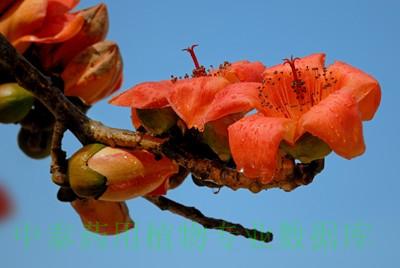| [English Name] | Common Bombax Flower | |
| [Chinese Name] | 木棉花 | |
| [Pinying Name] | Mumianhua | |
| [Latin Name] | Bombacis Flos | |
| [Genera] | Bombacaceae | |
| [Efficacy] | Antipyretic drug | |
| [Pictures] | Plant picture | Drug picture |

|
|
|
| [Alias] | ||
| [Source] | ||
| [Plant morphology] | ||
| [Distribution] | ||
| [Gathering and processing] | ||
| [Characteristics] | ||
| [Ecology] | It prefers warm climate, is representative species of tropical seasonal rainforest, doesn’t resistant to cold,likes light, resistants to drought,grows quickly, strong suckering ability, deep root, strong ability of anti-wind.It grows best in the thick、 fertile、acid and neutral soil.It likes high-temperature and high humidity climate, low ability of freeze resistance, branches freeze off in a long period of low temperature between 5~ |
|
| [Chemical composition] | ||
| [Pharmacological activities] |
1. Hepatoprotection: Kapok, root and ceiba xylem water extract show heoatoprotection on acute liver injury mice or rat model induced by carbon tetrachloride or D-galactosamine[1-3]. 2. Effect on Bacterial: Kapok red pigment show bacteriostasis activity on escherichia coli, staphylococcus aureus, Aspergillus 3. Anti-inflammatory: Acetic ether extract show an anti nonspecific inflammation activity on rat or mice pedal and auricle swelling model[2,6]. common bombax root water inhibit pedal swelling induced by Carrageenan[3]. 4.Anticancer: Kapok alcohol extract anticancer activity in vivo and on oral epithelium cancer, human gastric cancer, human leukemia and carcinoma of prostate in vitro and leukemia and S180 mice in vivo. Common bombax root extract or a monomer show similar effect on cancer cell line[2]. |
|
| [Clinical trial] | Mumianhua (common bombax flower) Chronic simple rhinitis: mumianhua (dry goods) soaked in boilingwater inatead of tea drink. 1 week as a course of treatment, 2 coursescontinuation (withdraw other durgs during the treatment). 86 cases were treated.Results: 80 cases were cured, 6 cases improved, the total effective rate was 100%[1]. |
|
| [Properties] | ||
| [Medical and other Uses] | ||
| [Dosage] | ||
| [Cautions] | ||
| [Traditional usage] | 1.Hemoptysis, hematemesis 2.Bacillary dysentery, acute and chronic gastroenteritis 3.Diarrhea and dysentery induced by damp-heat 4.Sweating and dysphoria in summer | |
| [Toxicological studies] | ||
| [Pharmaceutical preparations] | ||
| [References] |
Pharmacologic Actions: [1]Chiu H F, et al. Am J ChinMed, 1992,20(3-4):257. [2] Qi Yiping, Guo Shunmin. Fujian Medical Journal, 2002,24(3):119. [3]Lin C C.Am J Chin Med,1992,20(2):135. [4] Yu Hongying, Yin Yan, Wu Yahong, et al. Food and Fermentation Industries, 2004,30(5):92. [5] Lin Yanwen. Journal of Microbiology, 2006,26(2):53. [6] Xu Jianhua, Huang Ziqiang, Li Changchun. Journal of Fujian Medical College, 1993,27(2):l10.
|
|